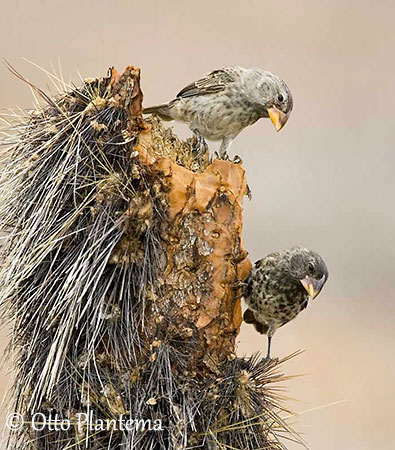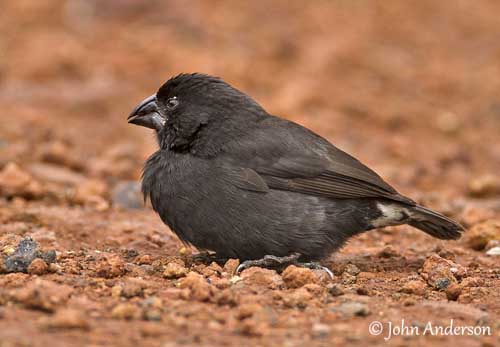
Fr: Géospize à bec moyen
All: Mittelgrundfink
Esp: Pinzón de Darwin Mediano, Pinzón terrestre mediano
Ital: Fringuello terricolo medio
Nd: Middelste Grondvink
Sd: Darwinfink
Photographers:
John Anderson
John Anderson Photo Galleries
Otto Plantema
Trips around the world
Text by Nicole Bouglouan
Sources:
HANDBOOK OF THE BIRDS OF THE WORLD Vol 16 by Josep del Hoyo- Andrew Elliot-David Christie – Lynx Edicions – ISBN: 9788496553781
BirdLife International (BirdLife International)
Neotropical Birds – Cornell Lab of Ornithology
Wikipedia, the free encyclopaedia
Medium Ground-Finch
Geospiza fortis
Passeriforme Order – Thraupidae Family
Darwin’s Finches - Generalities
INTRODUCTION:
As another example of the Darwin’s theory of evolution, the Medium Ground-Finch exhibited decrease in bill size on Daphne Major Island, after El Niño event (1982-83) involving heavy rains and reduced crop of hard, large seeds usually eaten by this species.
This event involved important small seeds crop, and these small seeds were abundant and available for two years after El Niño. A natural selection followed, and the Medium Ground-Finch became able to feed smaller food items.
DESCRIPTION OF THE BIRD:
Biometrics:
Length: 11-12 cm
Weight: 18-32 g
The adult male has almost entirely black plumage, with brown wash on wings and short, weak tail. The vent is white with black feather centres on undertail-coverts.
The robust bill is black during the breeding season. It becomes brown with orange tinge at base and yellow at tip during the transition period. And it is finally orange-yellow in non-breeding season.
The eyes are dark brown. Legs and feet are blackish.

The female is dark brown with pale buffy feathers edges overall. She appears paler than females of other species. The streaked pattern is more regular and shows less contrast between upperparts and underparts.
On the head, we can see a pale buff stripe on supraloral area and broken eyering. The pale buffy ear-coverts are streaked dark, whereas the neck side is pale buffy and almost unstreaked.
On the upperparts, mantle, scapulars and upperwing are scaled, but the uppertail-coverts are streaked.
On the underparts, the rows of dark streaks become obscure on belly and vent.
The bill is dark with orange tinge at base and yellow at tip, and can be orange-yellow according to the season.
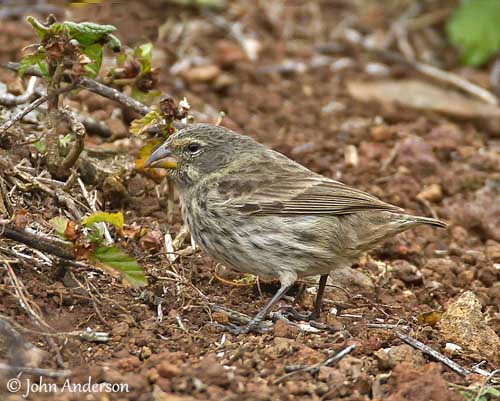
The immature male is intermediate between male and female, with black head and dark breast.
RANGE:
The Medium Ground-Finch is endemic to Galapagos Islands. It is found on several islands and offshore islets.
HABITAT:
The Medium Ground-Finch frequents forest edges and scrubby areas, but it can be found in all habitat types and at all elevations. However, it prefers arid lowland zones and transition areas where it is common.
During the non-breeding season, it is mostly seen in highlands.
CALLS AND SONGS: SOUNDS BY XENO-CANTO
The Medium Ground-Finch’s calls include high-pitched whistle “zeeeep” and nasal “chhhhp”.
The song includes 2-3 nasal notes “clzee clzee” followed by “tzeeuu tzeeuu tzeeuuu” notes. From studies of these sounds, song parameters depend on bill size.
The father’s song is imprinted on the young birds. Many dialects exist according to the habitat and the island.
BEHAVIOUR IN THE WILD:
The Medium Ground-Finch feeds on a variety of seeds, fruits and insects. It takes mainly small seeds, flowers of Opuntia helleri cactus, seeds of Tribulus plants and insects.
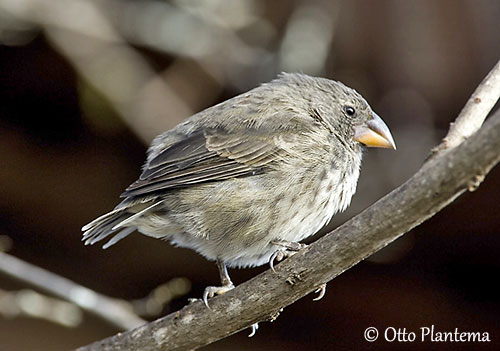
On Daphne Major Island, this Tribulus plant was the only available food during severe drought on Galapagos Islands, involving the decrease of the bill size of the birds. They have been able later to feed smaller food items.
The Medium Ground-Finch is monogamous. The male may build several nests where it displays. Then, both mates build the actual nest together.
The female chooses her partner through plumage and song, two important features during male-female interactions.
The Medium Ground-Finch is resident and only performs altitudinal movements outside the breeding season.
Like other Darwin’s Finches, it has rounded wings and only performs short flights, but it is able to hop and manoeuvre among dense vegetation.
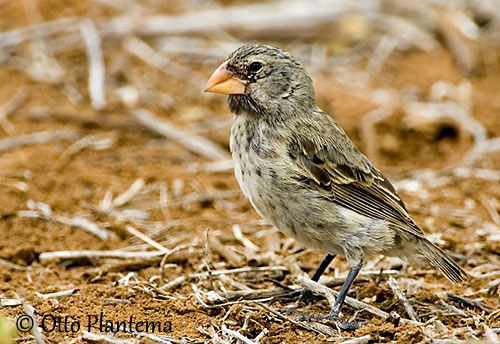
REPRODUCTION OF THIS SPECIES:
The breeding season is closely related to heavy rainfall and abundance of food.
The pair maintains a small territory which includes the nest-site. The male builds the dome-shaped nest with a side entrance. It uses dry grasses and other plant materials. The nest is placed in bush or cactus.
The female lays 3-4 whitish eggs with darker spots. The incubation lasts 12 days. The chicks are fed mainly with insects. They leave the nest about two weeks after hatching.
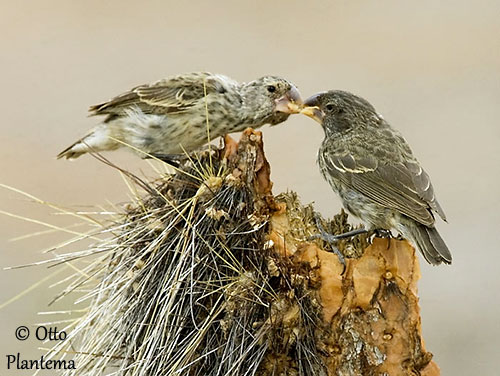
PROTECTION / THREATS / STATUS:
The Medium Ground-Finch is widespread and abundant in its range. In spite of the usual predators, this species is not currently threatened.
